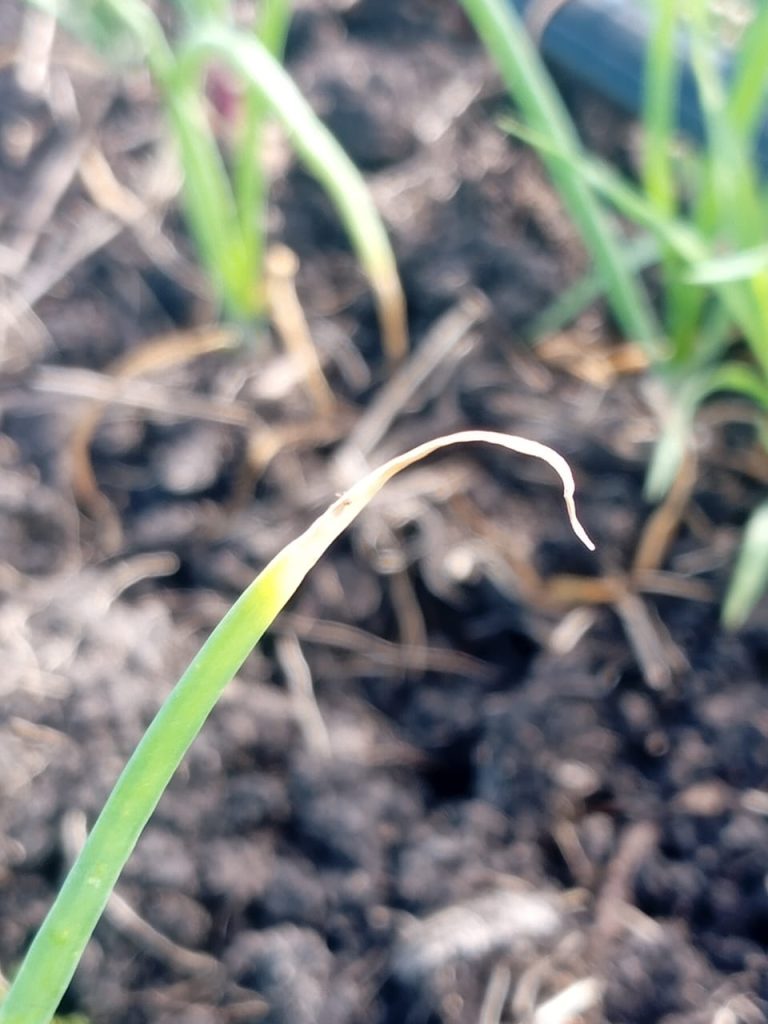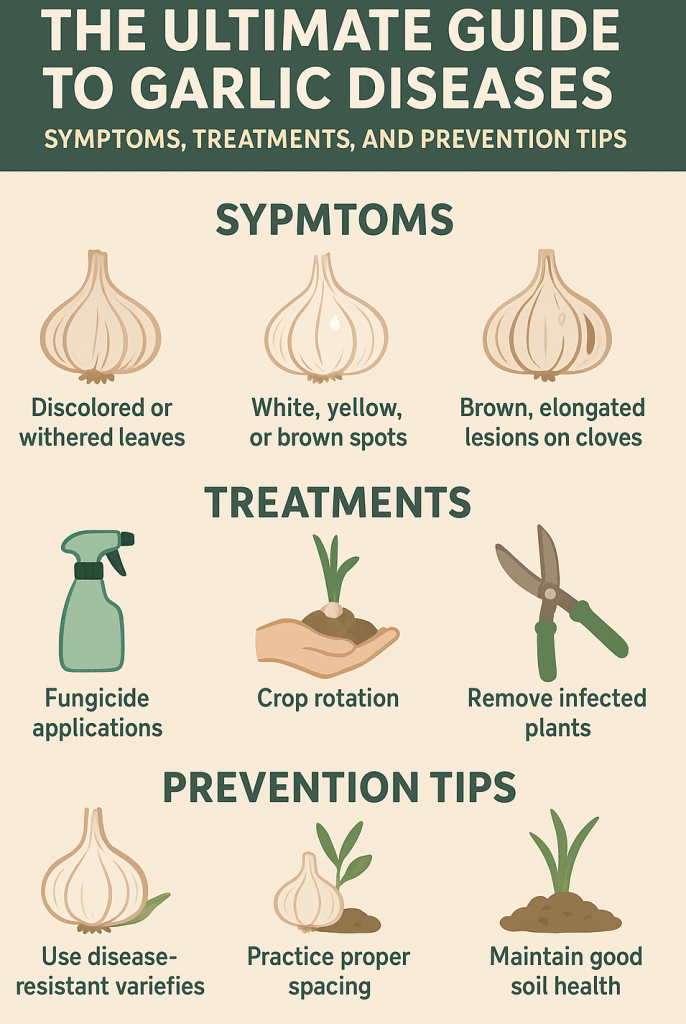Welcome to Onion Doctor, your go-to hub for all things alliums! Whether you’re a backyard gardener battling pesky pests or a pro farmer keeping your crops “clove”-ly, we’ve got you covered. Today, we’re diving into the world of garlic diseases – those sneaky villains that can turn your flavorful bulbs into mushy messes. But fear not! This guide is packed with fun facts, hilarious puns, and expert advice to help you “root” out problems and keep your garlic thriving.
Why focus on garlic? Well, this pungent powerhouse isn’t just a kitchen staple. Diseases can strike, but with early detection and smart strategies, you can save your harvest. We’ll cover the most common garlic diseases, their symptoms, causes, treatments, and prevention tips. Let’s make this the most engaging read on garlic disease symptoms and treatments out there!

WHAT CAUSES GARLIC DISEASES?
Before we “peel” back the layers on specific diseases, let’s talk basics. Most garlic woes stem from fungi, viruses, or bacteria lurking in soil, water, or infected seeds. High humidity, poor drainage, overcrowding, and cool temps are their playgrounds.
Common culprits include overwatering, planting in the same spot year after year (no crop rotation?), and using dodgy seed cloves. Prevention is key – think clean tools, disease-free seeds, and good airflow. Now, onto the rogues’ gallery of garlic diseases!
COMMON GARLIC DISEASES:
1.WHITE ROT:
Caused by the fungus Sclerotium cepivorum, it’s the most devastating garlic disease worldwide. It can linger in soil for decades, even without alliums around!
- Symptoms:
- Yellowing and wilting leaves starting from the tips.
- White, fluffy fungal growth on the bulb base, turning black with tiny sclerotia (like poppy seeds).
- Bulbs rot completely, becoming soft and smelly.
Causes: Cool, moist soil triggers it. Spreads via water, tools, or infected plants.
Treatment: Bad news: No cure once infected. Pull and destroy plants (trash, don’t compost!). Eat asymptomatic bulbs ASAP.
Prevention:
- Use disease-free seeds or hot-water dip cloves.
- Rotate crops – no alliums in the same spot for 4+ years.
- Solarize soil or replace top 6 inches if infested.
- Clean tools religiously!

2.FUSARIUM BASAL ROT:
This sneaky fungus (Fusarium oxysporum) attacks from below, making it a top query in “garlic disease symptoms.” It’s soil-borne and loves warm temps .
Symptoms:
- Yellowing leaves from tips down.
- Pinkish roots turning black; white or pink fuzz on bulb base.
- Bulbs soften and decay.
Causes: Damaged plants invite it in. Survives in soil forever.
Treatment: Limited options – store harvested bulbs at to halt spread.
Prevention:
- Choose resistant cultivars.
- Rotate with non-hosts (avoid corn, tomatoes).
- Ensure well-drained soil.

3.BOTRYTIS ROT(NECK ROT):
Caused by Botrytis porri.
Symptoms:
- Soft spots on necks or bulbs with dark brown/black spores.
- Yellowing outer leaves in severe cases.
Causes: Enters through wounds; thrives in humid storage.
Treatment: Apply copper fungicide pre-harvest. Eat or store immediately.
Prevention:
- Avoid over-fertilizing and damage.
- Dry bulbs well before harvest.
- Good spacing for airflow.

4.DOWNY MILDEW:
Not a true fungus but an oomycete (Peronospora destructor).It needs cool, wet conditions.
Symptoms:
- Pale to yellow/brown tip on the leaves.
- Bulbs turn watery and rot.
Causes: Moisture and high temperature ; spreads via spores.
Treatment: Early: Mancozeb or bio-fungicides. Late: Destroy plants.
Prevention:
- Space plants; water at soil level.
- 3-year rotation; destroy debris.

5. GARLIC MOSAIC VIRUS:
It is a duo of Onion Yellow Dwarf Virus (OYDV) and Leek Yellow Stripe Virus (LYSV), that result in mosaic or streaked patterns of light green or yellow on garlic leaves Spread by aphids – no cure, but manageable.
Symptoms:
- Mottled, striped leaves; stunted growth.
- Some plants asymptomatic.
Causes: Aphid-transmitted; latent in seeds.
Treatment: Pull infected plants to limit spread.
Prevention:
- Buy certified disease-free cloves.
- Control aphids with insecticidal soap.
- Test suspicious plants.

6.PURPLE BLOTCH:
Fungus Alternaria porri turns leaves purple in humid heat.
Symptoms:
- Water-soaked spots turning brown/purple with yellow halos.
- Bulbs redden and rot.
Causes: Wet leaves; needs water to spread.
Treatment: Copper fungicide every 3 weeks.
Prevention:
- Morning watering; good spacing.
- 4-year rotation.

7.RUST:
Puccinia porri brings the rust – orange pustules in cool humidity.
Symptoms:
- Reddish-orange spots on leaves; yellowing and wilting.
Causes:
High temperature and high humidity.
Treatment: Copper fungicide.
Prevention:
- Resistant varieties (e.g., elephant garlic).
- Remove debris.

TOP PREVENTION TIPS FOR HEALTHY GARLIC:
To wrap up:
- Crop Rotation: 3-4 years away from alliums.
- Soil Health: Well-drained, pH 6-7; test and amend.
- Seed Selection: Disease-free only!
- Water Wisely: Drip irrigation, not overhead.
- Monitor & Act: Scout weekly; use bio-controls like Bacillus subtilis.
Table: Quick Comparison of Garlic Diseases
| Disease | Key Symptom | Treatment |
| White Rot | White fluff & black dots | None; destroy |
| Basal Rot | Yellow tips, pink roots | Cool storage |
| Botrytis Rot | Black spores on neck | Copper fungicide |
| Downy Mildew | Yellow/Brown tips | Mancozeb |
| Mosaic Virus | Mottled leaves | Remove plants |
| Purple Blotch | Purple spots | Copper fungicide |
| Rust | Orange pustules | Copper fungicide |

Contact us for: Onion seedlings, Garlic seedlings, Germinated garlic cloves, Farm planning services, Soil testing, training on onion and garlic growing, Drip irrigation installation and maintenance, Agronomic support, Onion and Garlic value pack and Farm management. For free consultation, placing orders or booking a visit with an agronomist, please contact us via Call or what’s app +254703982228, Email: Info@oniondoctor.co.ke. You can also check out our social media handles for daily updates on TikTok: https://www.tiktok.com/@oniondoctorke?_t=ZM-8wmsTu0qumO&_r=1 Instagram: https://www.instagram.com/oniondoctorke?igsh=MTVoaHF3aWUydTJzaQ==Facebook:https://www.facebook.com/share/16SwgYn2dG/ Youtube:https://youtube.com/@oniondoctorke?si=u5Jnd-r0qU9UDYqL and Twitter: https://x.com/OnionDoctorKe?t=FR3JXlS_oN1vjjUgAtfyzg&s=09.